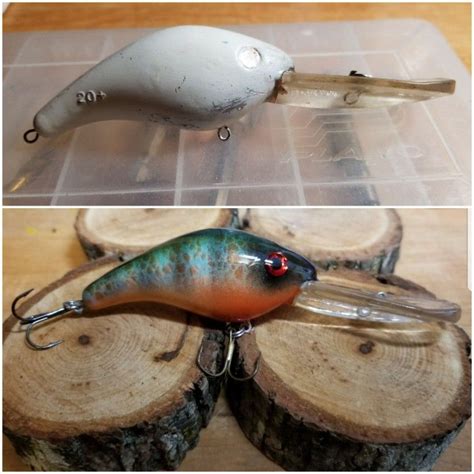No More Chipped Paint: Fishing Lure Restoration
For anglers, fishing lures are more than just tools; they're often prized possessions, imbued with memories of epic catches and cherished fishing trips. A chipped or faded lure can be heartbreaking, but don't despair! This comprehensive guide will show you how to restore your favorite fishing lures to their former glory, breathing new life into those trusty fishing companions. We'll cover everything from simple touch-ups to complete restorations, so whether you're dealing with minor scratches or significant damage, you'll find the solution here.
Why Restore Your Fishing Lures?
Beyond sentimental value, restoring your lures offers several practical advantages:
- Improved Catch Rate: A fresh coat of paint and sharp details can significantly impact a lure's effectiveness. Fish are visually attracted to bright colors and realistic details.
- Extended Lifespan: Restoring damaged lures prevents further deterioration, extending their usable life and saving you money on replacements.
- Enhanced Aesthetics: Seeing your favorite lures looking their best can be incredibly satisfying, boosting your confidence on the water.
Assessing the Damage: What Needs Fixing?
Before you begin, carefully examine your lures to determine the extent of the damage. This will guide your choice of restoration techniques.
- Minor Scratches & Chips: These can often be repaired with a simple touch-up using nail polish or specialized lure paint.
- Significant Paint Loss: Larger areas of missing paint may require more extensive repainting, possibly involving stripping the old finish.
- Broken Hooks or Hardware: Replacing bent or broken hooks and other hardware is crucial for safe and effective fishing.
- UV Damage & Fading: Exposure to sunlight can fade lure colors. A fresh coat of paint can restore vibrancy.
Tools and Materials You'll Need:
The specific materials needed will depend on the extent of the damage, but here's a general list:
- Acetone or Denatured Alcohol: For cleaning and removing old paint.
- Fine-grit Sandpaper (e.g., 2000-grit): For smoothing surfaces before repainting.
- Primer (optional): To improve paint adhesion.
- Acrylic or Enamel Lure Paints: Choose colors that match your lure or create a custom design.
- Clear Coat (optional): To protect the new paint and enhance durability.
- Small Brushes: For precise application of paint.
- Toothpicks or Fine-tipped applicators: For reaching small areas.
- New Hooks & Hardware (if needed): Replace broken or damaged components.
- Protective Gloves and Mask (recommended): To protect yourself from fumes and chemicals.
Step-by-Step Lure Restoration Guide:
1. Cleaning and Preparation:
Thoroughly clean the lure with soap and water, then remove any loose paint or debris using sandpaper. For significant paint removal, use acetone or denatured alcohol cautiously, following safety guidelines. Allow the lure to dry completely.
2. Repairing Chips and Scratches:
Use a fine-grit sandpaper to smooth out any rough edges or scratches. Apply a thin layer of primer (if using) and let it dry completely.
3. Repainting:
Apply thin coats of paint, allowing each coat to dry before applying the next. Multiple thin coats are better than one thick coat to avoid runs and drips. Use a toothpick or fine-tipped applicator to reach small details.
4. Applying Clear Coat (Optional):
Once the paint is completely dry, apply a few thin coats of clear coat to protect the paint and add durability.
5. Replacing Hooks and Hardware:
Replace any bent or broken hooks and other hardware, ensuring everything is securely attached.
6. Finishing Touches:
Once everything is dry, inspect your restored lure for any imperfections and make any necessary touch-ups.
Frequently Asked Questions (FAQs):
What kind of paint is best for restoring fishing lures?
Acrylic and enamel paints are popular choices for lure restoration. Acrylic paints are water-based, easier to clean up, and generally offer good durability. Enamel paints are more durable and resistant to chipping, but they require solvents for cleanup.
How do I remove old paint from a fishing lure?
Acetone or denatured alcohol can effectively remove old paint. However, proceed cautiously, test on a small inconspicuous area first, and always work in a well-ventilated area with appropriate safety gear.
Can I use nail polish to repair my fishing lures?
Nail polish can work for minor touch-ups and small chips, but it's not as durable as specialized lure paints or enamel paints. It's also not suitable for larger restoration projects.
How do I prevent my lures from chipping in the future?
Proper care and storage are key. Avoid throwing lures carelessly and store them in a protective case or tackle box to minimize damage during transport.
Where can I buy lure paint and supplies?
Lure paint and other necessary materials can be found at most sporting goods stores, tackle shops, and online retailers.
By following these steps, you can effectively restore your damaged fishing lures, ensuring they remain valuable assets for years to come. With a little patience and the right materials, you can bring back the beauty and functionality of your cherished fishing gear. Happy fishing!

